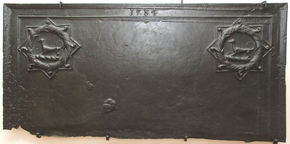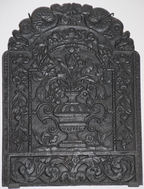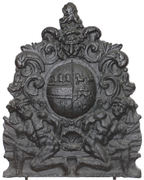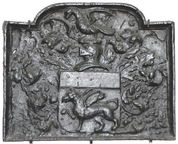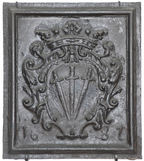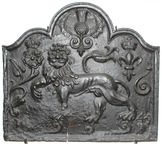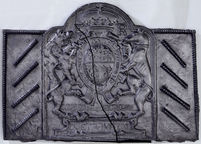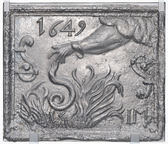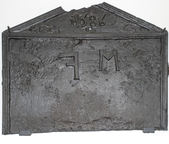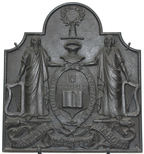-
752
Description: Rectangular; cavetto moulded edging on top and sides, with astragal and fillet inside; talbot crest within wreath and eight-pointed star, repeated at top corners; date top centre between mouldings.
Notes: The crest is probably that of the Parker family, of Ratton, near Eastbourne, Sussex. The base board appears to have been repositioned prior to the wreath stamps being impressed in the mould. Acquired from Marle Green Farm, Hellingly, Sussex, in 1896.
Inscription: 1584
- Decoration tags:
- rectangular (shape)
- carved stamps
- individual numbers
- heraldic
- text
- animals
- objects
Manufactured: in 1584 in the Weald area of England.
Current location: Victoria & Albert Museum, Cromwell Road, Kensington & Chelsea, Greater London, England.
Museum number: 780.1896 (part of the Victoria & Albert Museum museum group)
- Attached to series:
- Royal series
- Royal (wreath) series
-
755
Description: Arched rectangular central panel with bead-and-pellet edging; on a ground between two plants, a fluted flower vase with two, scrolled handles, tulips and other flowers issuing from the narrow neck; arched rectangular border with fillet edging; mirrored descending flower swags; along a rectangular bottom panel with fillet edging a symmetrical arrangement of swirled foliage; narrow, curved shouldered side panels with beads in oval depressions; on top, two mirrored sea serpents.
Notes: The presence of tulips suggest a Dutch origin for the pattern of this fireback, although the presence of several examples in England suggest that it was produced here rather than on the Continent; this is the smaller of two versions of this fireback.
Copies of this fireback are known.
- Decoration tags:
- 'Dutch' (shape)
- fillet (edging)
- whole carved pattern
- extension panels
- pictorial
- plants
- objects
Manufactured: in the late-17th century in England.
Current location: Victoria & Albert Museum, Cromwell Road, Kensington & Chelsea, Greater London, England.
Museum number: 41.1896 (part of the Victoria & Albert Museum museum group)
- Attached to series:
- British 'Dutch' style firebacks
- Flower Vase 'Dutch' types
-
757
Description: Within a surround of symmetrical swirled foliage, an oval armorial shield carried by two naked, kneeling male figures seated on a broad pedestal, between them a scallop shell; above the shield a lion’s face surmounted by a crest of a lion’s head erased. The arms are of Worge impaling Collier.
Notes: George Worge (1705-65), of Starr’s Green, Battle, steward of the Battle Abbey estate, married Elizabeth (1707-66), daughter of John Collier, town clerk of Hastings, in 1727. The arms of Worge have been variously blazoned, but the memorial to George Worge in Battle church indicates these tinctures: gules, a fess cotised or, in chief three lion’s heads erased of the last; Collier - argent, on a chevron azure, between three unicorns courant couped gules, as many oak sprigs fructed proper. This deeply detailed fireback might have been cast in a closed mould; it had a circular aperture in the centre into which, in this instance, an armorial was placed; the same armorial is on a fireback, dated 1762, at Great Dixter, Northiam, Sussex, as is the lion crest (no. 1317).
Arms: Worge impaling Collier (George and Elizabeth Worge)
- Decoration tags:
- baroque (shape)
- complex individual (edging)
- whole carved pattern
- pictorial
- armorial
- humans
Manufactured: in the early- to mid-18th century probably at Robertsbridge Furnace, Salehurst in the Weald area of England.
Current location: Victoria & Albert Museum, Cromwell Road, Kensington & Chelsea, Greater London, England.
Museum number: 686.1899 (part of the Victoria & Albert Museum museum group)
- Attached to series:
- Baroque series
- Personal armorial firebacks
- Worge/Collier series
-
758
Description: Flattened arched rectangular shape; cavetto moulded edge all round; armorial; arms of Browne family of Brenchley, Kent: Gules, a griffin passant or, a chief of the second; Crest: a vulture proper, wings endorsed, displuming a mallard’s wings.
Notes: John Browne, gunfounder, was granted arms in 1626. His principal furnace was in Brenchley parish, Kent. The royal gunfounder 1615-51, he petitioned the Crown for a monopoly of casting firebacks in 1633.
Copies of this fireback are known.
Arms: Browne of Brenchley (John Browne)
- Decoration tags:
- rectangular with round arch (shape)
- cavetto (edging)
- whole carved pattern
- armorial
Manufactured: in the early- to mid-17th century possibly at Brenchley and Horsmonden Furnace in the Weald area of England.
Current location: Victoria & Albert Museum, Cromwell Road, Kensington & Chelsea, Greater London, England.
Museum number: 493.1901 (part of the Victoria & Albert Museum museum group)
- Attached to series:
- Personal armorial firebacks
-
762
Description: Rectangular; astragal and fillet edging; oval shield of the Paulet family (sable three swords, points conjoined in pile), within a cartouche, surmounted by a marquis’s coronet; date split between bottom corners.
Notes: The arms of Charles Paulet, 6th Marquess of Winchester, who succeeded to the title in 1674 and was created Duke of Bolton in 1689. The fireback is reported to have come from Grange Farm, Basing House, Hampshire; Basing House was the seat of the Paulets.
Copies of this fireback are known.
Inscription: 16 87
Arms: Charles Paulet, 6th Marquess of Winchester
- Decoration tags:
- rectangular (shape)
- astragal & fillet (edging)
- whole carved pattern
- individual numbers
- armorial
- text
Manufactured: in 1687 possibly at Sowley Furnace, Beaulieu in England.
Current location: Victoria & Albert Museum, Cromwell Road, Kensington & Chelsea, Greater London, England.
Museum number: M.103-1913 (part of the Victoria & Albert Museum museum group)
- Attached to series:
- Personal armorial firebacks
- Paulet firebacks
-
763
Description: Quasi-Arched rectangular shape with cyma reversa shoulders; ovolo edging; stylised lion passant guardant; crowned rose with leaf and stem on left, crowned fleur de lys on right, thistle with leaves above centre; three right-facing scrolls at base; down-facing scroll, with staple, on right side; date split between bottom corners; initials below date, bottom right.
Notes: Blatantly Royalist in its symbolism, a variant (no. 901) is dated (perhaps more convincingly) 1641. Numeral style, initials, leaf depiction and the stapled scroll are typical features of firebacks made from patterns by the same maker. A later version of the same subject, but with a different shaped plate and without the fleur-de-lys, is also known (see 'Royalist series'). M. A. Lower writes of firebacks of this design of being cast at Waldron Furnace in Sussex (Lower, 1849, p.219).
Copies of this fireback are known.
Inscription: 16 49 / IM
- Decoration tags:
- rectangular with round arch (shape)
- ovolo (edging)
- whole carved pattern
- heraldic
- royal
- text
- animals
Manufactured: in 1649 possibly at Brede Furnace in the Weald area of England.
Current location: Victoria & Albert Museum, Cromwell Road, Kensington & Chelsea, Greater London, England.
Museum number: 492.1901 (part of the Victoria & Albert Museum museum group)
Citation: Lloyd, N., 1925, 'Domestic Ironwork I', Architectural Review, 58, pp. 58-67.
- Attached to series:
- IM series
- Hooked '1' series
- Stapled scroll series
- Brede group
-
768
Description: Arched rectangular shape with rounded corners; ovolo within fillet moulding all round; oval Tudor royal shield with garter surrounding, topped with a royal crown; dragon and greyhound supporters; initials split by crown; inscription on a fillet between legs of supporters, behind garter finial; motto on an Ionic plinth at bottom; two rectangular side panels with twisted rope edging top and side; a short length of turned dowel stamped four times, diagonally, on each panel.
Notes: The supporters are those of Henry VII or Henry VIII, but the initials suggest the fireback dates from the reign of Edward VI (1547-53). John Harvo (d. c1565) was a gunfounder who has been identified as occupying Pounsley furnace, Framfield, Sussex, possibly from as early as 1547; the fireback may have been cast originally during the reign of Henry VIII (1509-47), with the initials added to an early casting using the original pattern. The disparity between the worn surface of the armorial panel and the greater clarity of the extensions indicates that the extended casting was made using an already well-used armorial fireback and therefore at a substantially later date.
Copies of this fireback are known.
Inscription: E R / HONY SOIT QVE MAL Y PAYNCE / Made in Sussex by John Harvo / DV ET MOVN DROI
Arms: Tudor royal - Probably Henry VIII
- Decoration tags:
- rectangular with round arch (shape)
- rope (edging)
- carved stamps
- whole carved pattern
- individual letters
- extension panels
- armorial
- royal
- text
- objects
Manufactured: in the late-16th century in England.
Current location: Victoria & Albert Museum, Cromwell Road, Kensington & Chelsea, Greater London, England.
Museum number: 685.1899 (part of the Victoria & Albert Museum museum group)
- Attached to series:
- Pounsley series
- John Harvo series
-
769
Description: Rectangular; cavetto-moulded edge; a snake rises from a fire and bites the middle finger of the hand of a sleeved left arm that descends from a top right corner cloud; left and right, ‘S’ scrolls appear strapped to the edge of the fireback; the date, top left of centre; initials, bottom right corner.
Notes: An illustration of the New Testament episode (Acts 28: 3) when St Paul, shipwrecked in the island of Malta, was putting sticks on a fire and a viper bit him. The distinctive shape of the ‘1’ in the date and the initials, ‘IM’, together with the ‘S’ scrolls, parallel such features in other firebacks. The design is an adaptation of an illustration in 'Devises Heroiques' by Claudius Paradin (1557) which was translated into English by Geoffrey Whitney as 'The Book of Emblemes' (1586).
Copies of this fireback are known.
Inscription: 1649 / IM
- Decoration tags:
- rectangular (shape)
- cavetto (edging)
- whole carved pattern
- biblical
- text
- animals
- humans
Manufactured: in 1649 possibly at Brede Furnace in the Weald area of England.
Current location: Victoria & Albert Museum, Cromwell Road, Kensington & Chelsea, Greater London, England.
Museum number: M.119-1984 (part of the Victoria & Albert Museum museum group)
Citation: Hamling, T., 2010, Decorating the 'Godly' Household (New Haven, Yale), pp. 251-2.
- Attached to series:
- IM series
- Hooked '1' series
- New Testament firebacks
- Brede group
-
771
Description: Rectangular with triangular pediment; stepped fillet and ogee moulded edge; initials in rectangular panel (F reversed); date in pediment.
Notes: The triangular top is a separate element, in this instance impressed before the lower panel. A variant at Hastings Museum (no. 118) has the letters positioned slightly differently.
Inscription: 1586 / FM
- Decoration tags:
- triangular arched (shape)
- stepped fillet and ogee (edging)
- individual letters
- date stamp
- text
Manufactured: in 1586 in the Weald area of England.
Current location: Victoria & Albert Museum, Cromwell Road, Kensington & Chelsea, Greater London, England.
Museum number: M.129-1913 (part of the Victoria & Albert Museum museum group)
- Attached to series:
- 1586 series
- Date & initials firebacks
-
772
Description: Cavetto canted arched rectangle; astragal edging; oval inscription surrounding a central battlemented shield bearing an open book, with a baronet's escutcheon above; above, a helm with a crest of an arm and hand holding a wreath; on each side, a druid supporter holding a harp, each upon a horizontal fillet; below, intertwined bell flowers behind a tripartite motto scroll.
Notes: The motto appears to have been incorrectly spelled; the Conroy baronetcy was created for Sir John Conroy, comptroller of the household of the Duchess of Kent, and much hated by her daughter, Princess (later Queen) Victoria; the 3rd (and last) baronet succeeded to the title in 1869.
Inscription: FIDELITER ET CONSTANTER [Faithfully and constantly] / L'ANTIQIVITE NE PEVX PAS L'ABOLIR [Antiquity cannot abolish it]
Arms: Conroy, baronet, of Llanbrynmair (Sir John Conroy, 3rd baronet, 1845-1900)
- Decoration tags:
- rectangular with canted top corners and round arch (shape)
- astragal (edging)
- whole carved pattern
- armorial
- text
- humans
Manufactured: in the late-19th century in England.
Current location: Victoria & Albert Museum, Cromwell Road, Kensington & Chelsea, Greater London, England.
Museum number: 502.1896 (part of the Victoria & Albert Museum museum group)
- Attached to series:
- Personal armorial firebacks
- Welsh armorial firebacks
